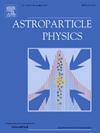Cosmological study in Myrzakulov F(R,T) quasi-dilaton massive gravity
IF 2.9
3区 物理与天体物理
Q1 ASTRONOMY & ASTROPHYSICS
引用次数: 0
Abstract
This study explores the cosmological implications of the Myrzakulov quasi-dilaton massive gravity theory, a modification of the de Rham–Gabadadze–Tolley (dRGT) massive gravity theory. Our analysis focuses on the self-accelerating solution of the background equations of motion, which are shown to exist in the theory. Notably, we find that the theory features an effective cosmological constant corresponding to the massive graviton, which has important implications for our understanding of the universe’s accelerated expansion. To assess the validity of the Myrzakulov quasi-dilaton massive gravity theory, we employ two datasets: the Union2 Type Ia Supernovae (SNIa) dataset, consisting of 557 observations, and the Pantheon SNIa data, which includes 1048 SNe I-a events gathered from diverse SN I-a samples. Our results demonstrate that the theory is capable of explaining the accelerated expansion of the universe without requiring the presence of dark energy. This finding supports the potential of the Myrzakulov quasi-dilaton massive gravity theory as an alternative explanation for the observed cosmic acceleration. Moreover, we investigate the properties of tensor perturbations within the framework of this theory and derive a novel expression for the dispersion relation of gravitational waves. Our analysis reveals interesting features of the modified dispersion relation in the Friedmann–Lemaître–Robertson–Walker (FLRW) cosmology, providing new insights into the nature of gravitational waves in the context of the Myrzakulov quasi-dilaton massive gravity theory.
米尔扎库洛夫 F(R,T)准迪拉顿大质量引力中的宇宙学研究
本研究探讨了 Myrzakulov F(R,T) 准迪拉顿大质量引力理论的宇宙学意义,该理论是对 de Rham-Gabadze-Tolley (dRGT) 大质量引力理论的修正。我们的分析侧重于背景运动方程的自加速解,结果表明该理论中存在自加速解。值得注意的是,我们发现该理论具有与大质量引力子相对应的有效宇宙学常数,这对我们理解宇宙加速膨胀具有重要意义。为了评估Myrzakulov F(R,T)准稀释大质量引力理论的有效性,我们使用了两个数据集:Union2 Ia型超新星(SNIa)数据集(由557个观测数据组成)和Pantheon SNIa数据(包括从不同SN I-a样本中收集的1048个SNe I-a事件)。我们的结果表明,该理论能够解释宇宙的加速膨胀,而不需要暗能量的存在。这一发现支持了米尔扎库洛夫 F(R,T)准穹顶大质量引力理论作为观测到的宇宙加速的另一种解释的潜力。此外,我们还研究了该理论框架内张量扰动的特性,并推导出引力波色散关系的新表达式。我们的分析揭示了弗里德曼-勒梅特-罗伯逊-沃克(FLRW)宇宙学中修正频散关系的有趣特征,为在米尔扎库洛夫 F(R,T)准迪拉顿大质量引力理论背景下研究引力波的性质提供了新的见解。
本文章由计算机程序翻译,如有差异,请以英文原文为准。
求助全文
约1分钟内获得全文
求助全文
来源期刊

Astroparticle Physics
地学天文-天文与天体物理
CiteScore
8.00
自引率
2.90%
发文量
41
审稿时长
79 days
期刊介绍:
Astroparticle Physics publishes experimental and theoretical research papers in the interacting fields of Cosmic Ray Physics, Astronomy and Astrophysics, Cosmology and Particle Physics focusing on new developments in the following areas: High-energy cosmic-ray physics and astrophysics; Particle cosmology; Particle astrophysics; Related astrophysics: supernova, AGN, cosmic abundances, dark matter etc.; Gravitational waves; High-energy, VHE and UHE gamma-ray astronomy; High- and low-energy neutrino astronomy; Instrumentation and detector developments related to the above-mentioned fields.
 求助内容:
求助内容: 应助结果提醒方式:
应助结果提醒方式:


